Cara Gilger's Blog, page 7
September 1, 2020
Three Policies Your Church Needs Now
Church policies often become dated over time, having been developed at a moment when a staff grew to a size where one was needed, an issue arose that demanded clearer boundaries between employees and staff or there was a large enough cultural shift that the church policies needed changing or creating. The challenge is that these documents often become stagnant relics that are marched out and negotiated with when the need arises but aren’t revisited and updated at consistent intervals for changes in best practice. To further complicate things, these documents are often adapted versions of corporate policies that don’t fit the culture or demands of church ministry.
Instead, in my work as a congregational consultant, I try to get churches to understand their policies as living documents that reflect the theological values and organizational movement of the church. Living documents because they can and should be revisited, tweaked and adjusted to reflect best practices as they evolve. A church’s policies reflect how they understand people, parenthood, illness, boundaries and grace. I can’t tell you how many churches I have worked with that were desperate to attract young families but did not have maternity leave for young clergy. Our policies are also a vehicle for communicating to staff who the church is and where the church is moving. If you want a dynamic, mission oriented, community based ministry but policy requires all clergy meet the requirements of 35 office hours a week, you will not have the ministry you dream of as an organization. If your church understands Jesus’s commandment to care for those at the bottom of the power structures but doesn’t protect your own hourly staff from on the job injury, your policy and your theology don’t add up.
A world wide global pandemic may not seem like the best time to tackle policy, but this is an important time to model dignity for workers and clarity of policy and practice. The church is all too often inclined to replicate corporate policies, despite the fact our organizations are oriented towards a different understanding of power and justice. While following your state employment laws are essential, the policies and practices of our churches should reflect the best ethical practices for employees. In fact the church can model an employer/employee relationship that models boundaries, clarity and dignity to our latity who often set the policies in their own work place. Clarity is also something that employees deserve right now, when participating in the work environment could potentially expose them to a life-ending illness. It is important for organizational morale and transparency to have policies in place that help employees feel safe and valued all of the time, but especially now. Below are three policies that your organization to should have in place now to help address the global Covid 19 pandemic:
Ministry Continuity Plan
A Ministry Continuity Plan is an outline of how the essential functions of the church will continue if key members of staff are incapacitate either short or long term and unable to do their work. This is a plan that all churches should have regardless of Covid 19, but now is the time to get one in place. It is a policy that aims to answer the questions: If something catastrophic were to happen or key members of the ministry staff were unable to work, who is in place to continue the ministry of the church? What recommended plan do you have so that payroll continues? Worship and pastoral care? Who has access to who’s emails and log in credentials in an emergency situation? The last thing you want is to have to track down the church management software credentials for a hospitalized staff person.
Emergency Work from Home Policy and Covenant
In an emergency how does your organization plan to accommodate working from home? What plan is there to provide the technology and equipment staff need to do their work well? How does the church covenant with staff, particularly ministry staff, to support effective work that is accountable to vision while at the same time prevent burnout from overworking? What hours at home are staff expected to be available, particularly support staff such as administrative assistants, financial staff and operations staff? What are the expectations for staff to be trained in and adapt new technology? The goal of a Work from Home Policy is to establish boundaries and expectations, while also communicating support and flexibility. While these questions are not exhaustive, they should get your policy setting body thinking about how to support employees through unexpected circumstances.
Return to Work Plan
The goal of this policy is not to have all the answers but to communicate a sense of care for employees, how your church will maintain a safe work environment and how your church will make decisions when issues arise that prioritize the safety of employees in the work environment. Under what circumstances will employees return to onsite work? What cleaning accommodations will be made to keep employees safe? If an employee is exposed to Covid-19 what is the chain of communication? Are they required to quarantine at home until they can produce a negative test? Is quarantine work from home time or sick leave? If an employee chooses to expose themselves to high risk activities and needs to be quarantined on whose time will that quarantine happen? When an employee has contracted Covid-19 under what terms are they allowed to return to work? Does an employee need a doctor’s release to return to work after Covid-19? What about members of their household that are still contagious? What are the newly developed laws at the state level that provide insight to what is permissible to ask?
When policies are unclear, it breaks trust and disrupts workplace productivity. The church more than other institutions needs to inspire trust in its community and model what employee dignity and safety looks like for the wider community. Whether your employees are members of your church or not, they are community evangelists for your organization as they share with friends and family what their work experience is as part of your organization.
While denominational structure varies in terms of who sets and implements policy, your policy making body should develop these tools for ministry. Each policy should be run through the proper decision making channels. Pastors should never develop and implement policy alone without the knowledge, input and support of a larger governing body of the church. It is also important to note that your policy needs to follow all the state and federal employment laws that apply to faith based non-profits.
If you need help thinking through best practices for these or other policies or would like someone to help draft your policies, Cara Gilger Ministries works with congregations to create structures, practices and policies that align with the vision and values of your church. Schedule a virtual consultation via our contact form HERE.
August 20, 2020
Prayer Dice for Digital Worship
Last week I shared the Worship Boxes I had built for children to engage in multi-sensory teaching over digital platforms. I wanted to create something that could engage children through out the liturgy we use for our thirty minute worship and lesson. It needed to be sustainable because I don’t want to burden families with the financial or logistical pressure of restocking materials. The worship boxes also needed to help draw quiet kids out of their shell over a digital platform and give busy, chatty kids some focus to their sharing.
One of the key components to the Worship Boxes are prayer dice. I was able to find 2″ blank foam dice at our local teacher supply store. I chose foam over wood because I wanted something that would be quiet when we were un-mute on our digital platform and that wouldn’t drive parents crazy and that created a sense of prayer time. I then used a thin tipped permanent marker to write a different prompt for prayer on each of the six sides.
The prompts I used for our prayer dice that we use with elementary aged kids were:
Family
Friends
A worry or concern
A joy or celebration
Our world
School
When we use them in worship I let them either roll the dice and think of something they would like to pray for using that prompt or I let them turn the dice on each side choosing which one they want prayer for, sharing it with their camera and the group. I usually ask a few follow up questions like “Do you want to pray for a specific friend or just your friends in general?” or “Is there something specific you are worried about or do you just feel worried this week?” I am amazed that with these small prompts how the kids open up to share more about their lives. I get to hear about the big family expedition to the park that gave everyone a break from home and much needed joy. I get to hear about worries over family that are sick and school starting back. The point for me is to use them as a tool for connection, not use them in a rigid or specific way.
Using this tool along with the “When I Listen to Scripture I Can Listen and Wonder” prompt card are two small ways we’ve made Children’s Worship more interactive, multi-sensory and engaging when our kids are burned out using digital platforms.
When I Listen to Scripture I Can Wonder and Draw Sample
I received so many inquiries on the post on Worship Box for multi sensory learning over digital platforms that I thought I would share what I created.
The goal was to provide open ended prompts for the students to engage scripture using their white boards or a piece of paper and pencil. I wanted to give them an invitation into the scripture so that they could engage their own wonderings and imagination. In addition to giving kids an entry point to scripture, I also helps keep busy hands and minds occupied during scripture stories. With kids being stuck on Zoom for school, adding something interactive and creative while listening to the story helps engage their creativity and active minds and bodies.
This document shows what I placed on the prompt cards: When I Listen to Scripture I Can Wonder and Draw…
August 13, 2020
Worship Boxes for Digital Children’s Worship
This summer I have had the opportunity to lead the Children’s Ministry at Park Avenue Christian Church while their Children’s Minister is on sabbatical. Working with children several states away via a digital platform has been joyful. This diverse and multi-aged group of kids living in the epicenter of the pandemic likely won’t return to in person worship and Sunday School for a while, so I wanted to create a resource that could help sustain them for a prolonged season of digital connection and faith development. I wanted to create something that could increase engagement across our digital platform, encourage multi-sensory learning and create a sense that our time together was sacred.
I developed worship boxes that aim to do just that! The worship boxes contain all of the resources to do interactive worship and lessons, centering on reusable resources that can draw children into the story of God alive in the scripture and in our lives, connect them to one another through prayer and sharing and I wanted all the supplies to be self contained in a box they could get out to signify it was time to worship.

I included the following resources:
Basic supplies such as construction paper, crayons, washable markers and child safe scissors.
Precut card stock book marks for creating memory versus, decorating and marking scriptures
Reusable sensory items to use to reflect on the Bible story or teaching themes such as play doh and wicky stix
A dry erase board, dry erase markers and eraser to reuse as we learn, draw and imagine the scriptures
A laminated prompt card “When I Listen to the Scriptures I Can Wonder and Draw”
A laminated book of our liturgy we use to frame our time together
A battery operated candle for our liturgy
A foam dice with prayer prompts to help them think about who or what they might pray for this week
Each family received a box with their name on it. Families with multiple siblings got duplicate supplies such as the white board, play doh and wicky stix. I chose a box that was large enough that families could also place their Spark House Children’s Bible or other Bible in the box with the materials. We treat the boxes as sacred, which means we leave all the materials in them so we can use them to encounter God’s good word for us each week.
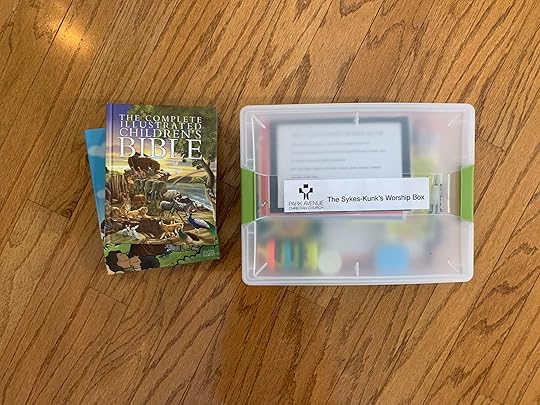
If you are interested in any of the resource I have listed, please reach out and I can share. These were so fun to put together but even more fun to use with the kids to help them grow in their faith and connection to each other during a socially distant time.
August 12, 2020
Why a Coach Might Be Right for You Right Now
My husband came home to our apartment to discover me facedown on the living room floor, bag cast aside a few feet from my sleeping body, shoes kicked off, dress clothes rumpled but still on. I was snoring audibly or so he said, before tapping me lightly on the shoulder to wake me. It was a Thursday evening and I wish I could say this was the only time that he found me splayed out like a sleepy starfish in that drafty old apartment our first year in Indianapolis.
My first year of ministry like many students straight out of seminary was exhausting. The constant waves of newness and first times made it hard to gain footing. No matter how many questions you ask, or how well your search committee vows to support you or how many detailed notes you take in the first year of any new call, you don’t know what you don’t know. And the surprise of what you don’t know is a constant destabilizing force in the first year.
That year marked my first experience with a clergy coach. Someone who understood the nature and oddities of ministry, maintained a deep spiritual commitment to exploring what God is up to and a wealth of practical wisdom. Clergy coaching is not therapy–but it does presume an emotional intelligence and health for the work. Clergy coaching in not spiritual direction–but it employs tools from spiritual direction and presumes spiritual health and curiosity. At its heart it is a companioned journey to listening to what God is calling you towards.
Those two years my coach slowly taught me how to ask better questions of myself as a leader, think critically about how to do my work and be a better colleague to my staff team. It was dense work, but good work that I have carried into the following decade of ministry.
In each new phase of ministry I have found outside wisdom profoundly helpful in processings and proceeding with transition and transformational work that centers in listening to who God is calling me to be and what God is calling me to see. That is the beauty of coaching, it is a way to have someone meet you where you are, practice deep listening to your context and ask questions from an angle that you may not have considered yet.
There is no other time ripe with possibility and filled with unknown transition and strategic transformational work than during a world wide global pandemic that is forcing organizations to rethink how they connect, inspire and create meaning in people’s lives.
So a coach might be the right tool if you are experiencing transition either personally or within your organization. This can include a change in your own work portfolio or call, staff transitions or realignments, transitions in ministry program offerings or leadership, or a change in missional priorities. All of these pivotal moments can be an excellent moment to engage in an outside perspective to ground the process and a partner to listen to the joy of what God is calling you or your ministry team to next.
Transformation of missional or personal ministry practice is another moment in which the time might be right to engage in coaching. Transformation is the convergence of circumstances and Spirit and ministry leaders can often find benefit from engaging in a conversation partner and set of questions that are informed by context but not entrenched in the context itself.
When we ask a different set of questions, often it’s not new answers we receive, but new perspective and insight. A coach can help ask better questions and shift perspective in ways that open up new possibilities. Coaching is a space of both deep listening to God as well as creative solutions.
The old adage says “what got you here won’t get you there.” Sometimes we need help discerning and articulating the next actionable steps of our vision or work. We know where we are, we know where we want to go, but we aren’t sure how t
All in all coaching might be a right fit for you if you need a conversation partner outside of your context that is committed to understanding your context while practicing excellent listening and providing insight grounded in experience and spiritual disciplines.
June 30, 2020
Allowing Braver Questions to Shape Us
I was listening to a panel discussion hosted by my judicatory ministry led by black leaders in my area when one of my colleagues, Dr Irie Session said “white people need to cultivate an ethic of bravery.” I grabbed a pen and scribbled it down on a post-it note pad I had sitting on my desk. All week I have been sitting with that quote. It stares up at me while I read, while I write and while I have wrestled slowly through the next phases of this consulting ministry I am building.
White people need to cultivate an ethic of bravery.
A whole sermon in a sentence. Right there on a pale pink post-it note, staring up at me and asking me–what’s the next level of this anti-racism work you have been doing for years? And what are you willing to brave for it?
Every quarter I take a day to do a retreat. I spend half the day in silence just listening. No phone, no computer, no email, I often go into the woods on a trail nearby and walk and listen and notice. I try to marvel in what God has done in the past few months and get curious about what God might be inviting me to think about next. The second half of the day I sit with my notebook open and four questions I ask my business.
What is working well?
What needs to be changed to work better?
What isn’t working and needs to be let go?
What is God inviting me into next?
I developed these questions and this process out of years of program ministry evaluation and spiritual development. Everything about my business gets laid on the table–from business management software, to clients, to how I am dividing my time, to my own spiritual life. All of it. It’s more than a chance to check, it’s an invitation to take inventory, be accountable and elevate what I am doing.
I believe in the power of asking the better question to shape a ministry, a heart, a life. The questions that we ask shape us. But they also sustain the work that we do that stretches beyond a single season or moment. A good question can anchor us to the work we are called to do as we ride the waves of that work. A good question will sustain us in burnout and endure failure and mistakes. A good question can help us build something better than our imagination can do on its own. A good question invites the creativity of the Spirit into the work that we do and the world we are building. And a good question can hold us accountable.
With the newest wave of police brutality and racial awareness gripping the moral imagination of our country I am realizing that it is time for a new set of questions. Not only from my business but for my family and our lives. It’s time to elevate the work we are doing in our community. And so each month I am going to ask myself “what did I do as a white person to cultivate an ethic of bravery?”
What concrete, actionable steps did I take to create the world I want to see in terms of not just my business and ministry but my family and community? What investments of time, education and resources did I make toward cultivating a white ethic of bravery? How did I educate myself on the best ways to be brave so my bravery creates space and thriving for others instead of self-congratulatory virtue signaling? What white privilege did I spend to create currency for my colleagues in the Black community? Who am I surrounding myself with that are also committed to this work of bravery in the name of racial justice and dismantling white supremacy?
Notice I didn’t craft the question to say “what CAN I do?” We can all talk about intentions and well meaning future plans. History is a burning dumpster fire of good intentions and white people with abandoned goals to do better. Like the questions I ask my business, this is a question that makes me reflect on what I have done so I can think about what I will do. Reflective accountability partnered with forward commitment, the two in constant conversation have proven an effective way to drive my work and ministry forward.
What did I do to cultivate an ethic of bravery?
It’s a question we should all be asking.
Like what you’ve read? Want more? Sign up for my twice a month newsletter (because we’re not spammy) and get original content you can’t find here on the blog. Reflections on faith and living, book recommendations and other good, nerdy fun. Sign up HERE.
June 17, 2020
Poetry for Beginners: How to Read and Fall in Love with Poetry
I often talk about how reading poetry plays an important part of my reading and spiritual life. I try to read a poem a day, often in the morning over a steaming cup of coffee or a glass of water before I put my pen to my to-do list or crack open email. I find poetry to be incredibly grounding. As the theologian Ellen Davis says “poetry is language that speaks to the heart…to our imaginations.”
Poetry and prayer both invite us to slow down and notice, to pause and be present.
And yet, I understand why so many people are not big poetry readers. As a middle school and high school mentor that has wrestled through the poetry unit homework with my mentees and as a mother of elementary age kids, I am saddened by how dull and flattened poetry is taught. I would hate or find no use for poetry too if my only experience ended in school.
Fortunately in college after being gifted a copy of Mary Oliver’s collection New and Selected Poems, I slowly discovered the joy of poetry. The way that poets can in a single phrase or image capture a whole wealth of human experience is like no other form of writing. The way they say so much with so few words is a gift to my harried and verbose spirit.
The more I talk about poetry, the more I hear from people “I wish I was into poetry.” Or “I want to get into poetry, but have no idea where to start.” So I thought I would pull together a guide to poetry for beginners. In it are a few tips, tricks, resources and advice for how I became someone who didn’t think poetry had much to offer me to someone who reads it daily and finds it a deeply enriching part of my life.
Throw Out Everything You Learned in School
No wonder very few people like poetry when in school we are taught that every poem has some sort of hidden meaning beyond the words that we are to excavate if only we are intellectually worthy enough. Rules and dissection set the tone so much that they slice away any joy or wonder. This elitist attitude not only creates exclusivity when the reader doesn’t “get it” (I never got it in school) but it’s thoroughly untrue. Poetry is like fiction or any other kind of art–it’s layered and multidimensional. Some poets will say “my work is straight forward, it says what it says” while others will say there are layers of meaning while others will claim it’s all about the second life that comes to the poem when the reader makes it their own.
Ditch the Old Dead White Guys
I supposed while we are throwing out everything we learned in school we should probably throw out all the dead white male poets that were foisted on us as the pinnacle of the art form of poetry. I have a soft spot for Edgar Allen Poe’s The Raven since I had to memorize it in the fourth grade too, but these men that we were present with are not the pinnacle of poetic creativity. Art is a privilege and many of the artists we studied in school created their art within the echo chambers of profound privilege which is reflected in the concerns of their work and the expression of their joy.
Poets of color, female poets and non-gender binary poets not only write from a different perspective and worldview but with a different language and cadence. Our imaginations are shaped by the world we live in and I tend to resonate toward work created by poets that bring a diversity of perspective and voice. I also find a richness in discovering some of the universal connections we share.
Try the work of of US poet laureate Rita Dove or bask in the queer black wisdom of Danez Smith or the protest poetry of Clint Smith III or the beauty of Naomi Shyab Nye or the native voice of Joy Harjo. There are so many voices out there expressing what it means to be alive and struggle and find beauty in this world.
First Poetry is About Feeling, Not Thinking
Now that we’ve tossed out our formal education and all the dead white guys, where to start? Start with feeling. How does the poem make you feel? The clues to how a poem makes you feel sits in the body. Does a line catch your breath? Can a turn of phrase tighten your chest? Are there images that cause your shoulders to relax and allow you to breathe out slowly? Did you make a small sign or furrow your brow at the closing line? Those are not first reactions to be brushed aside for more “intellectual” analysis, they are what poetry is made for–listening, noticing, feeling, thinking just a half turn differently about something mundane and extraordinary.
Slow Down, Slow Way Down
Our culture pushes us to move fast and produce and consume more. That attitude can surely bleed into our reading habits. Poetry, like yoga, invites my brain to slow down and be present, to take in each word, pause and phrase. You cannot skim poetry and get the gist. Poetry is absorbed best slowly, after taking a deep breath or a sip of water, allowing the words to unfold in their meaning and texture. Poetry invites readers into unhurried wonder and revelatory insight. So take a minute when reading to sit, to breathe, to read and experience. For this reason, I generally don’t sit down to read an entire volume in one sitting. Instead I will read one or two a day until I read the entire collection, give each piece the space in my head and heart to do its work.
Create Time and Space to Read
I find there are times of day and spaces in my world that make it easier to read poetry than others. I try to choose times a day when I am not distracted by the press of my work or responsibilities–first thing in the morning over my cup of coffee, after I have put away my phone before I go to bed. I need space to listen, over being entertained. And I like to read outdoors if I can particularly when the weather cooperates. The time I set aside is no more than ten minutes but it is ten minutes that feed my soul and ground my day.
Utilize Audio Resources
I am a person who can now say “I go to poetry readings.” I know, my friends say that makes me a next level nerd and it sounds so pretentious. But there is something about hearing someone read their own work with the intention and care and feeling behind it reflected in their own voice. The good news is you don’t have to attend a poetry reading to experience poets reading their work. There are several online spaces where you can hear poets read their work but one of my favorites is On Being’s Poetry Archive. On Being also offers interviews with poets that I have found moving, especially the interviews with Ross Gay and Mary Oliver. Another excellent resource is the podcast The Slowdown curated by United States Poet Laureate Tracy K Smith which brings listeners a brief word and a poem a day. Hearing a poet read their work can help you hear new inflection and emphasis that can help you understand and get more out of the experience.
Above all, find what you connect with and start there. If you are interested in seeing my favorite books of poetry you can check out my list HERE.
Like what you’ve read? Want more? Sign up for my twice a month newsletter (because we’re not spammy) and get original content you can’t find here on the blog. Reflections on faith and living, book recommendations and other good, nerdy fun. Sign up HERE.
May 30, 2020
Spring 2020 Reading Recap
Spring is always my slowest reading season of the year, as I spend my time in the yard gardening and soaking up the season before it turns brutally hot. Add in that by mid-March I became a full time home-school teacher and small biz owner and something had to give and unfortunately reading was one of the things I’ve had to do less of to do more of my new responsibilities.
I’m keeping with the format from my Winter Reading Recap 2020 because I like seeing the overall picture of how I am reading the books I consume. One thing that I noticed about my reading is that with the stress of sudden quarantine and new responsibilities this spring I read far more fiction and far less non-fiction. I am sure that has to do with wanting to relax and escape into a story and the fact that stress affects the brain’s ability to concentrate. I likely gravitated towards what I could reasonably process.
One other note I want to share before digging into the good, the bad and the ugly of what I read this spring. Many of you have sweetly reached out suggesting that I use an affiliate link to Amazon. Your encouragement has been so kind and yet, I have been hesitant for many reasons. One of them being that Amazon is a complicated ethical choice and I wasn’t sure that I wanted to make money from partnering with them. After doing some research I had decided to link the books I recommend and talk about to Bookshop.org. They offer books at an affordable price, donate 30% of the profits of your sale to a local bookstore of your choosing (as long as they have a relationship with bookshop.org) and are actively engaged in offering financial assistance to local bookshops across the country not just during Covid-19 but year round. While I love Amazon’s prices and fast delivery, they don’t create spaces to gather in our communities, they don’t bring in local authors for us to engage and they don’t give us a place for book lovers to browse in person. And yes, when you shop through Bookshop.org through any of the links on my website I will get a small percentage of the sale which is another way to support my writing and ministry. As always, I am thankful for this community’s thoughtful encouragement of my writing and work.
Now that that bit of transparency is over, let’s get on to the books.
Fiction
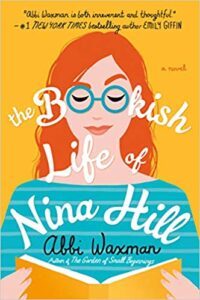 The Bookish Life of Nina Hill by Abbi Waxman
The Bookish Life of Nina Hill by Abbi WaxmanFormat: Hardcopy; Length: 352 pages
“It didn’t matter what hit the fan; as long as there were unread books in the world, she would be fine.” Occasionally I read a book that confounds the concept of rating books. In the pantheon of books I’ve read is The Bookish Life of Nina Hill spectacular, dazzling or life changing? Not at all. But is it a really good book for what it is—a light but thoughtful read about what it means to hide from social anxiety in the safety of books? Yes, yes it is. There was nothing particularly revelatory about Nina’s story and yet I found its simplicity and outright literary nerdiness a joy. The only child of an award winning, globe trotting photographer, Nina lives a simple life, she works at a bookstore, she’s on a trivia team, she enjoys movies by herself, she loves reading. Nina is content with her organized and controllable world until the day she is contacted by an attorney. Her previously unknown father has died and with his passing she discovers she has a rather large family filled with as many quirks as Nina. If you are looking for a light palette cleanser between heavier reads The Bookish Life of Nina Hill with scratch that itch.
 In a Dark, Dark Wood by Ruth Ware
In a Dark, Dark Wood by Ruth WareFormat: Audiobook; Length: 9.5 hours
I am picky about my mystery novels. I don’t like unreliable narrators and I don’t do domestic thrillers–no guessing who’s lying or who is crazier. I had read Ruth Ware before (Death of Mrs Westaway) so thought I would listen to this one since it’s been on my TBR forever and was available via the library. I liked several things about how Ware unfolds the plot to reveal her information slowly but on the whole I found the protagonist weak and simpering in a way I despise. From here on out I will stick to Tana French because she knows how to write strong, smart female protagonist.
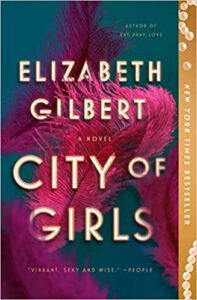 City of Girls by Elizabeth Gilbert
City of Girls by Elizabeth Gilbert Format: Audiobook; Length: 15 hours
This book was a damn delight. I don’t know what I was expecting about this book set in the theater scene in 1940’s New York City at the brink of the United States entering WWII, but it was funny, witty, sexy and entertaining. After dropping out of college Vivian is sent to live the summer with her aunt Peg, a theater owner with a loud, rowdy and rotating cast of showgirls, actors and writers. Looking back as a woman now in her 80’s, Vivian offers a funny and wry look at life as a young adult living for the first time in New York City. I had only read the non-fiction of Elizabeth Gilbert until this book and I am an instant convert to her fiction work. City of Girls will be a book I recommend over and over again to friends and family.
 The Impossible Girl by Lydia Kang
The Impossible Girl by Lydia Kang Format: Hardcopy; Length: 364 pages
This unexpected novel drops the reader in the middle of London in the late 1800’s where Cora, a young woman, is rumored to be born with two hearts. She takes up a job as a resurectionist stealing stranger bodies for medical dissection or museum display. As more and more people with anomalies end up dead of unnatural causes and rumors reach a fever pitch about the girl with two hearts, Cora senses that someone is tracking her down. This book was so good. The pacing created suspense without skipping character developmental and sense of place. I particularly loved that Cora disguised herself as Jacob, her “twin brother” offering a layered look at gender norms in this time period. The Impossible Girl is a good book if you want adventure in another time period and a little murder and suspense.
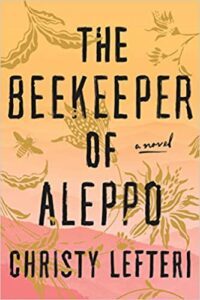 The Beekeeper of Aleppo by Christy Lefteri
The Beekeeper of Aleppo by Christy Lefteri Format: Audiobook; Length: 15 hours
“Where there are bees there are flowers and where there are flowers there is new life and hope.” A story of Syrian migration, Lefteri introduces us to Nuri a beekeeper and Afra, his wife, is an artist. They live a simple life, rich in family and friends, in the hills of the beautiful Syrian city of Aleppo—until the unthinkable happens. When all they love is destroyed by war, Nuri knows they have no choice except to leave their home. But escaping Syria will be no easy task: Afra has lost her sight, leaving Nuri to navigate her grief as well as a perilous journey through Turkey and Greece toward an uncertain future in Britain. Nuri is sustained only by the knowledge that waiting for them is his cousin Mustafa, who has started an apiary in Yorkshire and is teaching fellow refugees beekeeping. The Beekeeper of Aleppo was breathtaking in the beauty of its prose and in the way Lefteri was able to capture the peaceful and pastoral life of beekeeping in contrast to the disorienting experience of migration. While this story is about Nuri and Afra finding their way back to each other in their grief, what I found to be the most moving was the tenderness of male friendship between Nuri and Mustafa. I highly recommend this book to anyone who wants to broaden their knowledge about the experience of transcontinental migration from war.
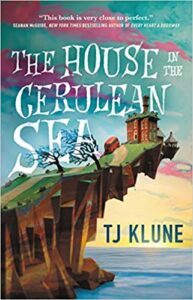 The House in the Cerulean Sea by TJ Klune
The House in the Cerulean Sea by TJ Klune Format: Hardcopy; Length: 393 pages
I came across this book at the end of 2019 on one of those “most anticipated books of 2020” it sounded interesting so I pre-ordered it and sorta forgot about it. Which is odd because I only pre-order about 6-7 books a year, otherwise I like to stick to my BOTM selections and wait after books release and the hype subsides to see if its worth the purchase. Nonetheless, this book arrived right when we entered quarantine and my attention was diminishing. Linus, a caseworker for the Department in Charge of Magical Children, is sent to an island orphanage that is home to six rare magical children, one rumored to bring about the end of the world. This book was a delightful surprise because it is at its heart about discovering our chosen family, the way children can be nurtured to heal from trauma and how we are all more than where we come from. At its heart, The House in the Cerulean Sea is a queer narrative of hope. When I shared I was reading it people asked—is it middle grade or adult fiction? I searched the publisher website and it’s published as adult fiction but it is absolutely appropriate for older Middle Grade or Young Adult readers.
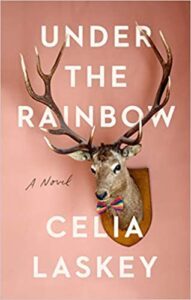 Under the Rainbow by Celia Laskey
Under the Rainbow by Celia LaskeyFormat: Hardcopy; Length: 288 pages
I finished this one in about 48 hours—not only is it a compact story with excellent pacing but the story of the members of Acceptance Across America a task force sent to Big Burr, Kansas, one of the most homophobic towns in America was so well done. Each of Laskey’s chapters is written from a different point of view—from townspeople to task force members—giving the books a kaleidoscope of perspectives, complications and a sense of understanding. What I loved the most is that Laskey unflinchingly examines what is broken in all of us and what we need to be whole. It was touching to see identities shift and solidify, ultimately making an argument that being loved and being able to love whether that’s romantic, familial or friendship is vital to human thriving. I loved Under the Rainbow and will be recommending it for quite some time.
 Such a Fun Age by Kiley Reid
Such a Fun Age by Kiley Reid Format: Hardcopy; Length: 305 pages
I’ve needed a few days to think about this book and that’s probably the best summary I can start with. The reviews I’ve seen readers have either loved it or did not care for it and while I really enjoyed this book, I get it. Such a Fun Age was layered and thought provoking and explored a lot of complex and nuanced forms of racism from an #ownvoices author. Unlike other popular fiction on race, Reid is unflinching in her writing of characters that are flawed, with complicated motives and ideas about race—there is no easy tie up or clear epiphanies, no one ends up being the good person and the white people don’t get to be white saviors. And I think that’s what makes this book good. If you’ve read Robin DiAngelo’s White Fragility this is the perfect fiction pairing to explore all the subtle ways that racism and prejudice shape how people interact. There were things in the book that made me cringe because I saw myself and people I know in them—well meaning but ignorant at best or self-serving at worst. At its heart this book is about how messy people are—how they learn and grow or don’t, how people develop and solidify their perspective and yet how vulnerable we all are at heart. As I’ve said before, I read to expand my understanding of perspectives other than my own and to grow. I will be thinking about this one for a while.
 Writers and Lovers by Lily King
Writers and Lovers by Lily King Format: Hardcopy; Length: 320 pages
This was not my first Lily King book so I was familiar with her sparse yet insightful style of writing. I found the way she wrote anxiety to be one of the most true to form descriptions I have found in fiction ever, which was a powerful experience to see something you know so intimately written and represented so well. I also appreciated Writers & Lovers for the sense of place that she created in the restaurant–the rhythm, personalities and quirks plus the way the work can sweep you away in a current of distraction for hours on end was so well written. I also really loved the ending–the way everything pulled together, the way Casey worked through her grief and gave herself some grace to be broken.
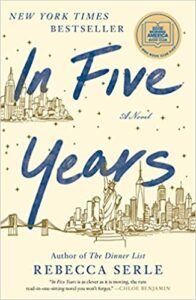 In Five Years by Rebecca Serle
In Five Years by Rebecca Serle Format: Audiobook; Length: 6 hours
Without the carpool line and quiet days to work long hours I haven’t been able to listen to many audiobooks since becoming a newly minted homeschool teacher. Shocker, but its hard to answer questions and help with reading and writing with earbuds jammed in your ears with a book going. But I finally figured out how to enjoy this book format–I can only listen to books short enough that my daily hour long walk allows me to complete a book before its due. It also has to be quick paced and engaging, which In Five Years fit that bill well. Dannie is about to land her dream job and get engaged to her long-time boyfriend and the perfect match for her ambition when she falls asleep and wakes up for only an hour five years in the future in a life that looks nothing at all like the one she meticulously planned. I liked this book far more than I thought I would because technically it’s a romance and I don’t read much romance (like one a year…or less). And truth be told, the romance was not the primary storyline–In Five Years is about best friends, loss and how grief can drive us to control what cannot be controlled.
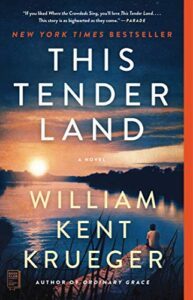 This Tender Land by William Kent Kruger
This Tender Land by William Kent Kruger Format: Hardcopy; Length: 455 pages
I don’t know if it’s a remnant of being a voracious reader as a child but I love an epic “clever kids on a heist” story. This Tender Land is set in the Midwest during the Great Depression as four orphans set out on the river one summer in search of family and freedom from the cruel Indian reform school they each found themselves living. This Tender Land will be one of my top reads of the year. Not only does it have that epic adventure vibe of a Mark Twain novel with a strange and interesting cast of characters along the way but the four kids Odie, Albert, Moses and Emma are each so interesting and different in what they are searching for on their adventure. There are also theological themes as Odie works out the suffering he’s seen in his short, difficult life that I appreciated for their nuance. I loved this one so much I wrote an extended review.
 The Moment of Tenderness by Madeleine L’Engle
The Moment of Tenderness by Madeleine L’Engle Format: Digital ARC; Length: 304 pages
I am a huge Madeleine L’Engle fan, reading the whole Wrinkle in Time series as a child and as an adult resonating with her poetry and writing on faith and creativity. I even had the chance to attend the Writing Conference to celebrate her legacy last year in NYC, it was an honor to meet her granddaughter. So I was incredibly excited to read this collection of short stories spanning her writing career. You can definitely see the progression of her writing in both style and voice and yet there is still a thread of the familiar L’Engle in it all. I love the way that she can just drop you in the story right from the start and invest you in a world and characters and that is still the case even in some of her earlier clunkier stories. The Moment of Tenderness is a fun book for L’Engle fans and I appreciate Net Galley for giving me the opportunity to read this book.
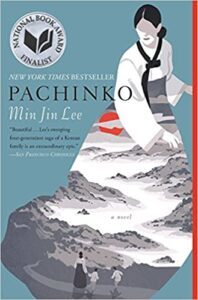 Pachinko by Min Jin Lee
Pachinko by Min Jin LeeFormat: Hardcover; Length: 490 pages
Pachinko is the sweeping intergenerational story of Sunja and her family as they struggle to establish themselves a Korean migrants in Japan. This story exposed me to an area of the world and the impacts of WWII and the subsequent Korean War that I was otherwise unfamiliar with from history classes (is anyone surprised). I enjoyed this book so much I wrote a full review you can read HERE.
 The Family Fang by Kevin Wilson
The Family Fang by Kevin WilsonFormat: Hardcopy; Length: 320 pages
The two Fang children known to the art world as Child A & Child B, featured performers in their parents’ chaos inducing performance art pieces, are grown up but not very well adjusted. Returning home after each ends up in a mishap of their own creation, Annie and Buster are forced to face the way their eccentric parents shaped them. The Family Fang is the kind of dark humored read I LIVE for. After reading two later books by Kevin Wilson (Nothing to See Here and Perfect Little World) I snagged this book which is one of his earlier works. I find Wilson’s body of work particularly fascinating for a couple of reasons. First Wilson has Tourette’s syndrome and I find the way his neurodiversity shapes his writing to be unique. He is able to create worlds and situations for his characters that are ridiculous, outlandish and absurd and yet utterly engaging and believable. He has a knack for creating one wacky element that drives the entire pretense of the book with such force. I also am interested in the way that in the three books I’ve now read that Wilson is especially interested in how we are broken by and redeemed from our upbringing. Also, fun fact for those who loved Nothing to See Here…the seeds of that book make an appearance in this one which was really cool. The Family Fang is not for everyone but if you dig Wes Anderson films or stories about messed up and darkly funny families or you appreciate a good dose of white nonsense this book is for you.
 Big Summer by Jennifer Weiner
Big Summer by Jennifer WeinerFormat: MArdcopy ARC; Length: 368 pages
This was one of the last books I read in May so it’s fresh, but I don’t quite know what to say. I am sure people will call Big Summer “genre bending” but I couldn’t figure out what kind of book it was trying to be. Was it a book about body image and online performance? A little. Was it a book about the nuances and complications of female friendship? Yes. Was this book a mystery? Kinda. Was it a romance? Sure, why not. Did this book talk about race and class without actually adding anything substantive to the conversation? Why, yes, yes it did. In other words, save your money and buy a book from this list to read this summer.
Non-Fiction
 It’s OK That You’re Not OK by Megan Divine
It’s OK That You’re Not OK by Megan DivineFormat: Hardcopy; Length: 280 pages
I picked this book up for my research and writing project, as I search for language and framing that makes sense for the work I am trying to articulate. It’s OK That You’re Not OK is an excellent resource for the grieving and for those who want to care well for the grieving. It’s not a book about how to rebuild but rather how to make it through the initial shock of grief.
Poetry
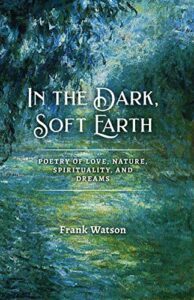 In the Dark, Soft Earth by Frank Watson
In the Dark, Soft Earth by Frank Watson I had the chance to read an ARC of this book of poetry courtesy of Net Galley. The poems are brief and some seemed almost incomplete but what I enjoyed about this collection was that each section of poetry opened with a piece of full color art to set the tone for the sections themes.
 Poetry of Presence: An Anthology of Mindfulness Poems eds. Phyllis Cole-Dai and Roby R Wilson
Poetry of Presence: An Anthology of Mindfulness Poems eds. Phyllis Cole-Dai and Roby R WilsonFormat: Hardcopy; Length: 245 pages
This collection is the perfect morning companion, offering a poem each day to create mindfulness and centering for the day. Featuring well known and some of my favorite poets such as Naomi Shihab Nye, Mary Oliver, Alice Walker, Rumi and others interspersed with poets that were new to me. I will be putting Poetry of Presence in the rotation with some of my tried and true volumes I use as part of my spiritual disciplines. My only complaint is that someone should have designed the cover better–such a lovely book and such a dated cover!
 The Tradition by Jericho Brown
The Tradition by Jericho Brown Format: Hardcopy; Length: 77 pages
The poet Jericho Brown was not on my radar until the 2020 Pulitzer Prizes were announced. I ordered up a copy of his award winning poems The Tradition and wow. They are beautiful and powerful. I will be reading and thinking about his work for a while.
As I look over this list of spring reads I can definitely tell that Covid-19 had an impact on my attention in significant ways. Not included in this list are the roughly half a dozen non-fiction books that I started, read half of or a few chapters and abandoned. Hopefully I can finish a few up this summer.
Like what you’ve read? Want more? Sign up for my twice a month newsletter (because we’re not spammy) and get original content you can’t find here on the blog. Reflections on faith and living, book recommendations and other good, nerdy fun. Sign up HERE.
May 27, 2020
My 2020 Summer Reading List
This summer is going to be unlike any other with the uncertainty of Covid spread. We cancelled our summer travel plans and will be continuing to practice social distancing since two of the beloveds in our bubble are high risk. Homeschooling has felt like a strange limbo somewhere between school and summer for months and so we enter the summer having already exhausted some of the tricks and tools we use to keep young minds engaged, occupied and out of fights. So this week I spent some time making a list of activities we can do at home with (mostly) items we already own. And I began thinking about what I might read this summer since I will have extra time to stretch out in the backyard while the kids swing and splash in the kiddie pool.
I am a mood reader which means I drift from book to book depending on my mood, with the exception of non-fiction which I try to impose some deadlines on so I complete those reads with consistency. It’s sort of the perfect balance between letting the mood move me and having a plan (I’m an Enneagram 1, I love a good plan). All of that is to say that my Summer Reading List is a compilation of books that I want to read this summer…but who knows if they’ll all make it onto my Summer Reading Recap List. Either way, here are some of the books I am looking forward to reading this summer. This list will be weirder than other lists out there because I am keeping it real–included are new release fiction, backlist fiction, poetry and non-fiction (particularly church leadership, theology and research books). In other words it’s the typical mash-up you’ve grown accustomed to getting from me.
New Release Fiction
 The Vanishing Half Brit Bennett
The Vanishing Half Brit Bennett I am keeping my new release fiction list short because I want everyone to check out the first two books on this list. The Vanishing Half Brit Bennett’s second novel after the wild success of The Mothers is one of my (and the rest of the bookish world’s) most anticipated read of the year. Early reviews are positive for this story of two white-passing sisters who grew up in the American South and are living two very different adult lives.
 Transcendent Kingdom by Yaa Gyasi
Transcendent Kingdom by Yaa GyasiTied with The Vanishing Half as the most anticipated book of the summer, Yaa Gyasi author of the moving and widely acclaimed Homegoing (if you have not read it, run to your local bookstore, this one is a must read) is releasing her second novel Transcendent Kingdom. Following Gifty a PhD student studying brain chemistry, this is a story about family, science and faith.
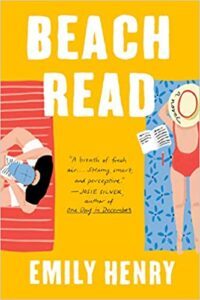 Beach Reads by Emily Henry
Beach Reads by Emily Henry I am not a big beach read person but reviews are out that this is not your typical summer fluff but instead a weighty book about two authors with side by side beach homes working through the complications of life. I enjoyed Lily King’s Writers & Lovers so I am hoping Beach Read is a similar struggling writer vibe.
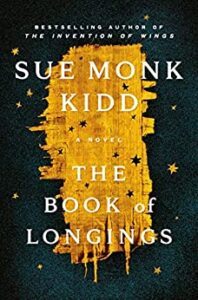 The Book of Longings by Sue Monk Kidd
The Book of Longings by Sue Monk Kidd A book that creates a fictional account of Ana, the wife of Jesus, has about a million ways that it could go wrong. Maybe a million and one, for this theologically trained reader to cringe. But after a seminary friend listened to this interview with the author Sue Monk Kidd and recommended it to me, I thought, “this doesn’t sound like an ill advised idea, it might be good. I’ll give it a shot.”
 These Ghosts are Family by Maisy Card
These Ghosts are Family by Maisy Card I received a copy of These Ghost are Family from the generous people at Simon Schuster via Net Galley and have yet to dig into what has been described as a sweeping intergenerational story of migration and identity in a similar vein to Homegoing. Reviews by #ownvoice reviews praise this book and so it’s time to move it off the to-be-read pile.
Backlist Fiction
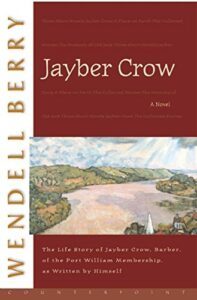 Jayber Crow by Wendell Berry
Jayber Crow by Wendell Berry I have long wanted to read Jayber Crow, not only because it get excellent reviews and shows up on every list of novels about progressive faith but I also adore Wendell Berry’s poetry and have found his non-fiction on agrarian life foundational to how I live my life. No pressure on this poor book, right?! But it’s time to stop being worried my expectations will let me down and finally pick this one up.
 The Overstory by Richard Power
The Overstory by Richard Power This Pulitzer Prize winner has been sitting on my shelf for a while now, as I have read mixed reviews from colleagues about it’s value in adding to the conversation on ecology and conservation. I generally defer to Native theologians and writers, whereas Power is a white man so I am going in a bit apprehensive. But I want to see what the hype is surrounding The Overstory and it’s sweeping family narrative set in and around trees (does anything sound more peaceful this summer than imaging you are in the forest?).
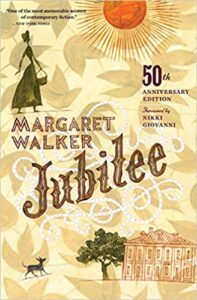 Jubilee by Margaret Walker
Jubilee by Margaret Walker Walker tells the story of Vyry, the daughter of a white plantation owner and his black mistress in this moving and unflinching tail of slavery in the south. This is another one that came on my radar from #ownvoice book reviewers’ consistent positive reviews. Walker was a prolific African American scholar and writer and I would love to read more of her work, so I will be starting with Jubilee this summer.
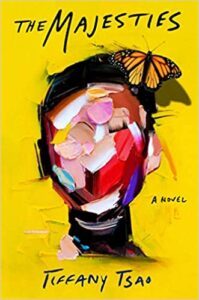 The Majesties by Tiffany Tsao
The Majesties by Tiffany TsaoPublished earlier this year (January) The Majesties is not too far of a backlist, but it’s also one I don’t want to let slip by. Narrated by Gwendolyn, the sole survivor of an attack that killed 300 people perpetrated by her sister The Majesties explores this wealthy family in all its manipulations and deceit that led to the tragedy that tears this sister apart.
Theology/Church Leadership
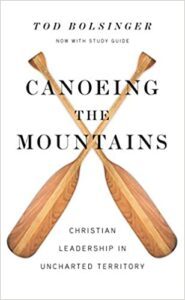 Canoeing the Mountains: Christian Leadership in Uncharted Territory by Tod Bolsinger
Canoeing the Mountains: Christian Leadership in Uncharted Territory by Tod Bolsinger The one book consistently recommended when I was at an eccumenical gathering of clergy was Canoeing the Mountains–each clergy person could excitedly recommend this as a book that spoke most closely to their experience navigating the church in these times. I can’t imagine that Covid has made this book any less relevant.
 Uproar: Calm Leadership in Anxious Times by Peter L Steinke
Uproar: Calm Leadership in Anxious Times by Peter L Steinke I read Steinke’s earlier work in seminary and appreciated his application of family systems theory to the work of doing congregational work. I am curious to see if his theories and insight still connect and if he’s added new insight to his earlier work in this newest work Uproar.
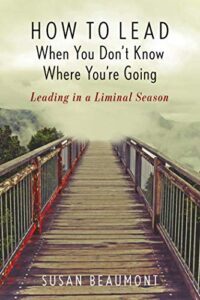 How to Lead When You Don’t Know Where You Are Going: Leading in a Liminal Season by Susan Beaumont
How to Lead When You Don’t Know Where You Are Going: Leading in a Liminal Season by Susan Beaumont A clergy colleague I deeply respect who is doing transformation work at their historic downtown church recommended How to Lead When You Don’t Know Where You Are Going as one that rang true to their experience and also pushed some edges of their transformation practices. Coupled with the fact that I deeply admire and appreciate Susan Beaumont’s work in church staff management and have attended several of her staffing seminars and I am looking forward to this one.
 Christianity and the New Spirit of Capitalism by Kathryn Tanner
Christianity and the New Spirit of Capitalism by Kathryn TannerThis read is what I call “Cara keeping it real” because it’s one of the books selected for reading and reflection by a clergy cohort group I am in. It’s dense, it’s assigned and I love that I will have accountability to make it through Christianity and the New Spirit of Capitalism with a paper and discussion due in July.
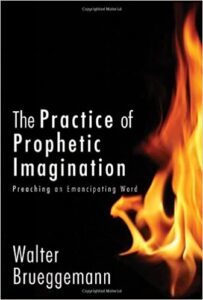 The Practice of Prophetic Imagination: Preaching an Emancipating Word by Walter Brueggemann
The Practice of Prophetic Imagination: Preaching an Emancipating Word by Walter BrueggemannIn part two of “Cara keeping it real” is our second book for the clergy cohort group, The Practice of Prophetic Imagination. I love everything Walter Brueggemann writes not because it affirms my own thinking but because it pushes me to consider a slightly different view or interpretation that challenges how I practice my faith. Although, a deadline and having to discuss it competently with colleagues will definitely help.
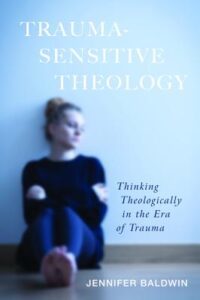 Trauma-Sensitive Theology: Thinking Theologically in the Era of Trauma by Jennifer Baldwin
Trauma-Sensitive Theology: Thinking Theologically in the Era of Trauma by Jennifer BaldwinRecommended by a former professor who has been an immense resource and encourager of my research grant, Trauma Sensitive Theology should be a helpful read to do some framing for the constructive portion of the book I am working on that intersects trauma and pastoral care.
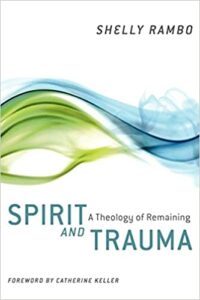 Spirit and Trauma: A Theology of Remaining
Spirit and Trauma: A Theology of RemainingAnother recommendation by a trusted colleague in the field, I am hoping to work my way through Spirit and Trauma to see if it offers any insights on the liminal nature of trauma and survival as it pertains to how we locate ourselves within communities of belonging.
Poetry
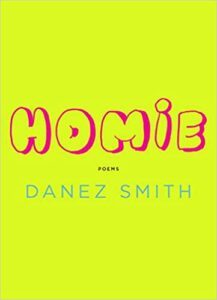 Homie by Danez Smith
Homie by Danez Smith The Easter bunny brought this volume of poetry by a queer black author and that’s the kind of resurrection I am looking for in the world! Despite my enthusiasm to receive a copy of Danez Smith’s most recent volume, I have yet to pick it up. So I will be reading Homie this summer over my morning coffee.
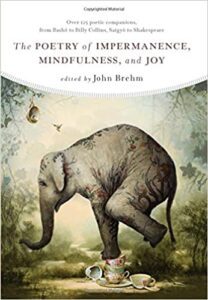 The Poetry of Impermanence, Mindfulness and Joy ed by John Brehm
The Poetry of Impermanence, Mindfulness and Joy ed by John Brehm This collection has been on my radar for a while, sitting in my cart of un-purchased books but I have enjoyed so deeply Poetry of Presence that I am looking for another collection to add to my rotation I read from each morning. I am hopeful that The Poetry of Impermanence, Mindfulness and Joy will be perfect for those slow summer mornings.
While I likely won’t get to all these titles, I am hoping to get to most of them while still allowing the spirit to surprise me with some unplanned reads. I am so curious–what are you hoping to read this summer? Any of these titles catch your eye?
Like what you’ve read? Want more? Sign up for my twice a month newsletter (because we’re not spammy) and get original content you can’t find here on the blog. Reflections on faith and living, book recommendations and other good, nerdy fun. Sign up HERE.
May 18, 2020
Sequins and Gratitude for the Small, Ordinary Details
Both of my children are competitive dancers. They dance year round, but starting in the late summer they meet with their teammates beginning a schedule of jazz, ballet and choreography to prepare them to compete in the spring. Like other athletes they discipline their bodies learning to stretch and move to their highest level of excellence. Until I saw first hand their sweaty faces emerging from the studio door after hours of throwing their body into graceful movements, coordinated with teammates who were working equally hard to make the movements of a single body into the movements of a group, I didn’t understand that dance was a sport.
Which is saying something because I am nothing like the dance moms that make reality television and neither are the other dance moms and dads I know. I don’t watch my kids dance, you will be surprised but I sit and read, prop my laptop on my actual lap and write or work on client projects while my children master the movement and anatomy of their choreography. I might poke my head in the door if I hear the instructor ask the girls to “stop giggling and pay attention” one too many times. We don’t demand they be perfect dancers (they are not, but they love it) but we do demand that they are respectful to their teachers.
This year our competition season was cut in half, bisected cleanly by the before and after of Covid-19. Two competitions under our belts, we took a break for Spring Break and never returned to class or stage. It was a strange sensation, like the way your inner ear sways back and forth when you suddenly hit the breaks from speeding to standstill.
This week we got an email from our studio that our costumes purchased for a long cancelled Spring recital had come in and we could sign up for a time slot to come pick them up one by one. I put my mask and hand sanitizer in my purse, the new liturgy of Covid and drove over at my appointed time slot, a tightness in my throat.
Our dance studio owner meets me at the door wearing a mask and gloves, a bag with my kids’ name written in sharpie six separate costumes crammed in the plastic confines. I open the back hatch of our car, which I backed up to the curb and stood back so she can safely place the items in there without coming in my space. I tell her how much we miss her and my kids wave from the window.
Our dance studio owner doesn’t just teach my children dance. She has a kind and gentle spirit that encourages the kids while still demanding they bring their best to the studio. She has shaped their character to be thoughtful, kind, confident kids. She is the one who can crouch down, look them in the eye and tell them the truth about who they are and watch their little chins lift and shoulders straighten in recognition of their belovedness. In the safety of her studio my kids have met some of their best friends, girls who are silly and funny and kind. The parents I’ve met through the studio and kind, thoughtful and generous–offering carpooling to events, tucking spare snacks in their bag for my child that’s always hungry, lending books to one another to read in cool, dark auditoriums, pouring good humor into what can be an intense competitive setting.
I bring the costumes back to the car and we pull over to an adjacent empty parking lot. Crowded around the back of our car, my kids and I take each one out of its packaging and ooh and ahh over the color, style, shape and accessories. One costume is covered in the most beautiful berry colored sequins. They are sewn in waves that stretch down to a bright raspberry tutu. Another costume comes with a tiny seafoam green sequin pillbox hat and little white gloves. The kids shriek and squeal with delight over fringe and tutus. I begin to tear up in the small details of a life we no longer live, a life whose details small, intricate and beautiful were lost to me until they were truly lost. These unnoticeable and mundane details seemed precious in a moment where we can no longer revel in the richness of so many tiny details I had been taking for granted.
Every small sequin that made up the dazzling simplicity of our lives I had been taking for granted. We were never a “busy family.” Instead we opted for a simple, home centered life, with a few selected activities. But those activities were chosen with care and intention, a care and intention that had worn off over time until we forgot how much they truly made our life richer–not because of the passing of time they offered but because of the small details of those relationships.
I don’t know what after will look like on the other side of the sharp blade that has cut us as a culture in two. I know that I am changing and so are my children, I sense others are too and I know many of the changes will be for the good, cultivating a sense of wholeness that our former lives didn’t always align with fully. For me, though I will no longer take the small, shining details of the life we have chosen and created for granted. Whatever the future brings I will notice the details of each sequin sewn into the tapestry of my days, the relationships that shine reflecting the light of God’s love.
Like what you’ve read? Want more? Sign up for my twice a month newsletter (because we’re not spammy) and get original content you can’t find here on the blog. Reflections on faith and living, book recommendations and other good, nerdy fun. Sign up HERE.



